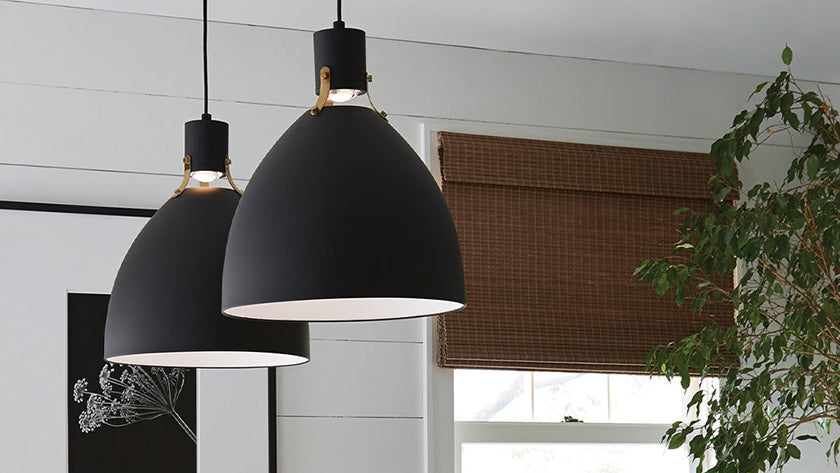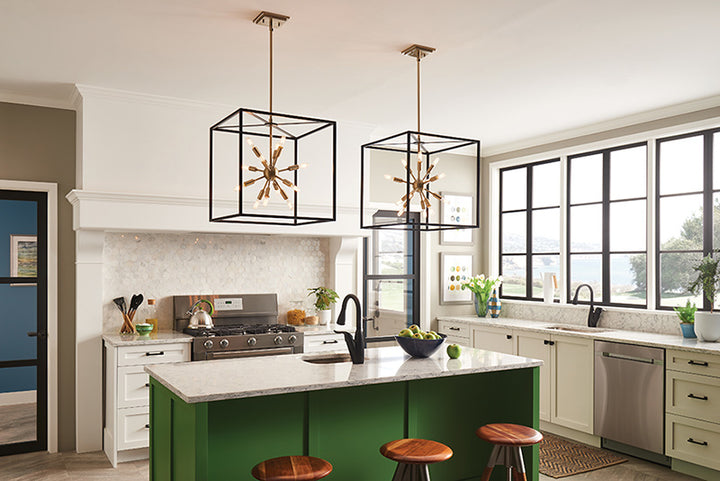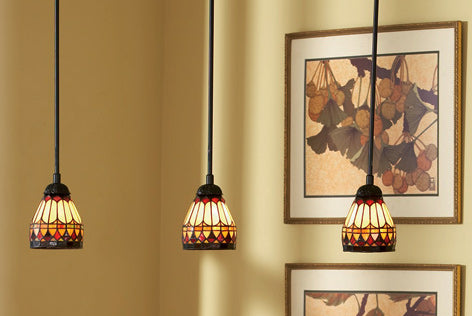
Pendant Lighting Buyer's Guide
Search
Pendants have become increasingly popular when current kitchen trends moved to an open floor plan, placing the kitchen into the public area and increasing its usage as a gathering space.
Pendants help break up the open space and provided comfortable lighting with a dramatic visual impact.They are designed as great decorative lighting, which says a lot about your personal style. Decorative lighting is meant to be seen and add huge visual style to a room. Because of this, pendant lighting now comes in a wide variety of colors, designs, and sizes.
Although you might be tempted to immediately purchase the first pendant light design that takes your fancy, it's important to purchase pendant lighting that will suit your space, your style and your lighting needs.
Here are four easy tips on how to buy a pendant light that is perfect for the specific needs of your living space.
Pendant Lighting Trends
Pendant lights are generally valued as task lighting fixtures as they are used to provide illumination for specific tasks or to create a focal point of light over a surface.This is why they are most often installed in kitchens. However, as the size and scope of pendant lighting has evolved into larger lighting designs like bird cage and globe style, and large drum shade pendants, pendant lighting and metal orb pendants, pendant lighting has infiltrated the chandelier space, and is popular over dining room tables and in entry ways or foyers due to distinctive linear down rods that appeal largely to minimalist or modern contemporary themes.
Our Lighting Style Index Page has nine helpful categories to help you narrow your choices and find the perfect pendant lighting.
Black pendant lighting, in addition to bronze, copper, and white dome pendant lighting, have become increasingly popular, as modern industrial warehouse lighting designs are the go-to kitchen decorating element when seeking to give your kitchen a cozy coffee house vibe.

Family rooms, living rooms and wet bars are places that benefit from pendant in not only the light they provide, but in creating ambiance. Pendant Orb and Globe Chandeliers as well as Caged Pendant Lights deliver the size and scale for larger spaces, while Medium- to Small-size Pendants (or Minis) add a focal point with a burst of color with an art glass or opaque glass shade. Need to maximize a small space? Then Caged Pendants or pendants with Transparent Glass Shades are recommended by interior designers.
With Pendant Lighting, you can easily add an elegant conversation piece and create a dramatic focal point in any room—including the bathroom! (Check out our Bathroom Lighting Buying Guide for bathroom lighting tips related to pendant lights.)
LED lights in pendant lighting fixtures are on the rise, especially for those homeowners that like colored lights. Although a little more expensive, colored LED lights provide more vivid colors compared to incandescent lighting. Mini bars are good places for colored pendant lights.
Begin your search for Pendant Lighting, visualizing the space or surface you want your pendant lighting to illuminate
- Browse lighting to look for pendant lights that would fit the design style of the room and the statement you envisioned.
- Pendant lights in dark colors like black, bronze, or copper are easier to clean than those with lighter colors. Check out Dark Finish Pendants and Black Pendant Lighting products!
- The size or diameter of the pendant(s) should be proportionate to the size of the room, the odd or even quantity of pendants, and the length of surface.

Determine the number of pendant lights needed
- Use multiple pendants for spaces longer than 4 feet.
- 60-75 watts are recommended for every 20 inches of counter space.
- Odd over even number of pendants are preference, as it provides a sense of balance, and visual appeal. While the odd number rule is important, it’s also important to consider situations where three pendant lights are too few, and five pendant lights are too overwhelming. Even-numbered décor is acceptable for practical reasons.
Determine the height
- The height should be close enough for lighting the space while providing an unobstructed view both sitting and standing.
- Pendant lights should be between 28–38 inches above the surface of the table or island where it is situated over. Assess the distance between the ceiling and the place where you want the lowest portion (in this case, the pendant) of your light will be.
- If you don’t have a surface, countertop, island, or table over which you want to install pendants, the fixtures should be about 72 inches above the floor.
Choose your mounting point
- The general design of a pendant light can be pretty straightforward, although there are actually different mounting points from which a pendant light is hung from a ceiling.
- A monopoint pendant is suspended from a single fixture on the ceiling (which usually also covers the light box). This type of pendant light offers the most versatility, as you can install individual pendants anywhere you want on the ceiling. Should you only need one or two pendant lights, this is your best choice.
- A monorail mounting points is a single track used to hang pendants from the ceiling. The track itself can be a point of aesthetic fascination. In fact, a group of pendant lights arranged around a creatively designed circular track can make just as good a centerpiece as a conventional chandelier.
- A multipoint mount closely resembles track lighting, and most people who employ this kind of pendant lighting use wires instead of down rods for their pendant lights. These pendant lights are great for bedrooms or places where you are allowed to push the bounds of creativity.
Questions to Ask Yourself before Purchase
What is your purpose for buying a pendant light?
Do you need it to light up your study table or your kitchen table? For busy work areas, you will need something that offers a lot of direct lighting in that particular space. On the other hand, if you need pendant lights largely for their design, you can opt for less bright lighting, or you can get yourself a dimmer switch. You can also achieve mood lighting with a pendant light that does not necessarily have too much brightness.
Low voltage and line voltage pendant lights?
Low voltage pendants have one distinct advantage: they are considerably less expensive than standard voltage pendants. They also have smaller bulbs and, consequently, smaller light fixtures which can save on space. If pendants are for task lighting standard voltage is recommended, low voltage/LED lighting is more for atmospheric lighting than task.
What kind of shade do I want?
Translucent lights are less limited when it comes to filtering light. This means that it illuminates the space around it in addition to the space below. Solid shades, on the other hand, cast light in a mostly downward direction. This is an important consideration, depending how you would like the light to give off. If you don’t want your pendants to cast a glow, you’re better off with solid shades.
Lighting Trends: What is In?
Pendant lights are generally valued as task lighting fixtures as they are used to provide illumination for specific tasks or to create a focal point of light over a surface.This is why they are most often installed in kitchens. However, as the size and scope of pendant lighting has evolved into larger lighting designs like bird cage pendant lighting and metal orb pendants, large pendant-style chandeliers, are popular over dining room tables and in entry ways or foyers due to distinctive linear down rods that appeal largely to minimalist or modern contemporary themes.
Family rooms, living rooms and mini bars are places that are benefiting more and more from the installation of pendant lights.They have even made their way into the bathroom! Check out the bathroom lighting buying guide for bathroom lighting tips on pendant lights.
LED lights in pendant lighting fixtures are on the rise, especially for those homeowners that like colored lights. Although a little more expensive, colored LED lights provide more vivid colors compared to incandescent lighting. Mini bars are good places for colored pendant lights.
Explore Topics


Comments